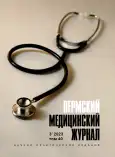Experience of transmural endoscopic drainage in treatment of pancreatic pseudocysts
- Authors: Kotelnikova L.P.1,2, Trushnikov D.V.2, Khlebnikov P.D.1
-
Affiliations:
- E.A.Vagner Perm State Medical University
- Perm Regional Clinical Hospital
- Issue: Vol 40, No 3 (2023)
- Pages: 92-99
- Section: Methods of diagnosis and technologies
- URL: https://journal-vniispk.ru/PMJ/article/view/254867
- DOI: https://doi.org/10.17816/pmj40392-99
- ID: 254867
Cite item
Full Text
Abstract
Objective. To evaluate the possibilities of transmural endoscopic drainage in the treatment of post–necrotic pancreatic pseudocysts in the immediate and long-term periods.
Materials and methods. From 2018 to 2022, a transmural endoscopic drainage method was used in the treatment of 36 patients with pancreatic pseudocysts at Perm Regional Clinical Hospital. The results were evaluated in the immediate postoperative period, 4–7 months before the removal of the stent and 1–4 years by the complaints of patients, blood amylase content, the results of ultrasound and CT examination of the abdominal cavity.
Results. Two-three days after the endoscopic intervention, the cyst completely disappeared in 30.56 % of patients, decreased by half or more of the diameter in 63.89 % and only in 5.56 % – decreased slightly. After 1–4 years, the absence of cysts was registered in 80 %, small diameter (from 15 to 24 mm) – in 10 %. Pancreatic cysts persisted in three patients (10 %). Statistical analysis showed that the wider was the main pancreatic duct and the higher the blood amylase level before transmural endoscopic drainage, the poorer was the treatment result.
Conclusions. Transmural endoscopic drainage of pancreatic pseudocysts makes it possible to achieve complete disappearance or significant reduction in the size of pancreatic cysts a year or more after the intervention in 90 % of cases. The clinical result of transmural endoscopic drainage in the treatment of pancreatic pseudocysts depended on the initial width of the main pancreatic duct and the level of blood amylase.
Full Text
##article.viewOnOriginalSite##About the authors
L. P. Kotelnikova
E.A.Vagner Perm State Medical University; Perm Regional Clinical Hospital
Author for correspondence.
Email: splaksin@mail.ru
MD, PhD, Professor, Head of the Department of Surgery with Course of Cardiovascular Surgery and Invasive Cardiology
Russian Federation, Perm; PermD. V. Trushnikov
Perm Regional Clinical Hospital
Email: splaksin@mail.ru
doctor of the Endoscopic Unit
Russian Federation, PermP. D. Khlebnikov
E.A.Vagner Perm State Medical University
Email: splaksin@mail.ru
resident of the Department of Surgery with Course of Cardiovascular Surgery and Invasive Cardiology
Russian Federation, PermReferences
- Parfenov I.P., Bedin V.V., Korzheva I.Yu., Vshabunin A.V., Komissarov D.Yu., Vengerov V.Yu. Low trauma treatment of chronic pancreatitis complicated by isolated pseudocysts of the pancreas. Moscow Surgical Journal 2018; 5 (63): 45–50 (in Russian).
- Lazutkin M.V., Ivanusa S.Y., Shershen D.P. Integrated use modern miniinvasive interventions under radiation guidance in the surgical treatment pancreatic cysts. Medical Visualization 2014; 4: 42–49 (in Russian).
- Pereira E., Caldeira A., Leite S., Moreira T., Moutinho-Ribeiro P., Nines N., Bispo M. GRUPUGE Perspective: Endoscopic ultrasound-guided drainage of peripancreatic collections. GE Port Journal Gastroenterology 2020; 28 (1): 39–51.
- Ivanusa S.Y., Lazutkin M.V., Shershen D.P., Eliseev A.V., Popov A.A. Differentiated approach to transmural endoscopic drainage in patients with pancreatic fluid formations. Moscow Surgical Journal 2022; (4): 9–19 (in Russian).
- Farias G.F.A., Bernardo W.M., De Moura D.T.H., Guedes H.G., Brunaldi V.O., Visconti T.A.C., Gonçalves C.V.T., Sakai C.M., Matuguma S.E., Santos M.E.L.D., Sakai P., De Moura E.G.H. Endoscopic versus surgical treatment for pancreatic pseudocysts: Systematic review and meta-analysis. Medicine (Baltimore) 2019; 98: e14255.
- Bang J.Y., Wilcox C.M., Arnoletti J.P., Varadarajulu S. Superiority of endoscopic interventions over minimally invasive surgery for infected necrotizing pancreatitis: meta-analysis of randomized trials. Dig Endosc. 2020; 32: 298–308.
- Proença I.M., Lera dos Santos M.E., Hourneaux de Moura D.T., Ribeiro I.B., Matuguma S.E., Cheng S., McCarty T.R, Silvino do Monte Junior E., Sakai P., Hourneaux de Moura E.G. Role of pancreatography in the endoscopic management of encapsulated pancreatic collections – review and new proposed classification. World J Gastroenterol. 2020; 26 (45): 7104–7117. Published online Dec 7, 2020.
- Popov A.A. Modern diagnostics and surgical treatment of pancreatic pseudocysts (Literature review). Izvesyia of the Russian military medical academy 2021; 40 (S 1–1): 125–128 (in Russian).
- Lazutkin M.V., Ivanusa S.Ya., Shershen D.P., Popov A.A. Modern drainage intervention in the surgical treatment pancreatic cysts. Izvesyia of the Russian military medical academy 2020; 39 (3): 82–85 (in Russian).
- Ivanusa S.Y., Demko A.E., Lazutkin M.V., Batig E.V., Kulagin V.I., Popov A.A. Minimally invasive external and internal drainage in the surgical treatment of pancreatic cysts. The Journal of Emergency Surgery named after I.I. Dzhanelidze 2022. 3 (8): 56–60 (in Russian).
- Feklyunin A.A., Romashchenko P.N., Maistrenko N.A.,Omran V.S. Prevention of complications of transpapillary endoscopic interventions. Bulliten of the Russian military medical academy 2021; 23 (3): 141–147 (in Russian).
- Malyuga Y.Yu., Davidova S.V., Klimov A.E.,, Gaboyan A.S., Kuprin A.A., Novoselova V.V. Potential for endoscopic treatment of patients with pancreatic psudocysts. Pacific Medical Journal 2011; 46 (4): 14–16 (in Russian).
Supplementary files










